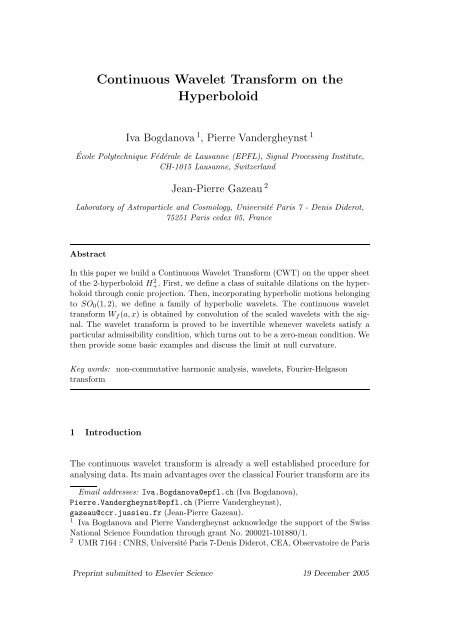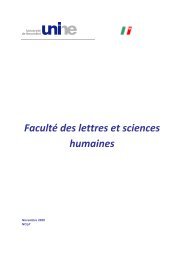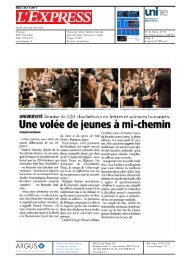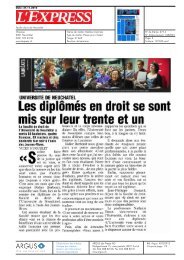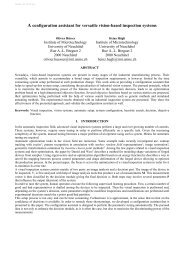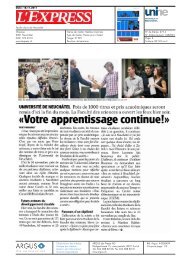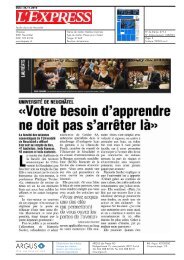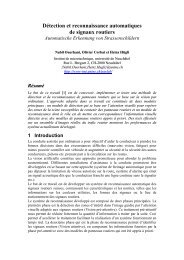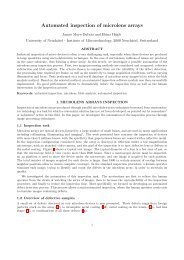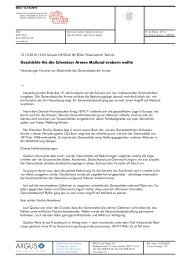Continuous Wavelet Transform on the Hyperboloid - Université de ...
Continuous Wavelet Transform on the Hyperboloid - Université de ...
Continuous Wavelet Transform on the Hyperboloid - Université de ...
You also want an ePaper? Increase the reach of your titles
YUMPU automatically turns print PDFs into web optimized ePapers that Google loves.
<str<strong>on</strong>g>C<strong>on</strong>tinuous</str<strong>on</strong>g> <str<strong>on</strong>g>Wavelet</str<strong>on</strong>g> <str<strong>on</strong>g>Transform</str<strong>on</strong>g> <strong>on</strong> <strong>the</strong><br />
<strong>Hyperboloid</strong><br />
Iva Bogdanova 1 , Pierre Van<strong>de</strong>rgheynst 1<br />
École Polytechnique Fédérale <strong>de</strong> Lausanne (EPFL), Signal Processing Institute,<br />
CH-1015 Lausanne, Switzerland<br />
Jean-Pierre Gazeau 2<br />
Laboratory of Astroparticle and Cosmology, Université Paris 7 - Denis Di<strong>de</strong>rot,<br />
75251 Paris ce<strong>de</strong>x 05, France<br />
Abstract<br />
In this paper we build a <str<strong>on</strong>g>C<strong>on</strong>tinuous</str<strong>on</strong>g> <str<strong>on</strong>g>Wavelet</str<strong>on</strong>g> <str<strong>on</strong>g>Transform</str<strong>on</strong>g> (CWT) <strong>on</strong> <strong>the</strong> upper sheet<br />
of <strong>the</strong> 2-hyperboloid H+ 2 . First, we <strong>de</strong>fine a class of suitable dilati<strong>on</strong>s <strong>on</strong> <strong>the</strong> hyperboloid<br />
through c<strong>on</strong>ic projecti<strong>on</strong>. Then, incorporating hyperbolic moti<strong>on</strong>s bel<strong>on</strong>ging<br />
to SO 0 (1, 2), we <strong>de</strong>fine a family of hyperbolic wavelets. The c<strong>on</strong>tinuous wavelet<br />
transform W f (a, x) is obtained by c<strong>on</strong>voluti<strong>on</strong> of <strong>the</strong> scaled wavelets with <strong>the</strong> signal.<br />
The wavelet transform is proved to be invertible whenever wavelets satisfy a<br />
particular admissibility c<strong>on</strong>diti<strong>on</strong>, which turns out to be a zero-mean c<strong>on</strong>diti<strong>on</strong>. We<br />
<strong>the</strong>n provi<strong>de</strong> some basic examples and discuss <strong>the</strong> limit at null curvature.<br />
Key words: n<strong>on</strong>-commutative harm<strong>on</strong>ic analysis, wavelets, Fourier-Helgas<strong>on</strong><br />
transform<br />
1 Introducti<strong>on</strong><br />
The c<strong>on</strong>tinuous wavelet transform is already a well established procedure for<br />
analysing data. Its main advantages over <strong>the</strong> classical Fourier transform are its<br />
Email addresses: Iva.Bogdanova@epfl.ch (Iva Bogdanova),<br />
Pierre.Van<strong>de</strong>rgheynst@epfl.ch (Pierre Van<strong>de</strong>rgheynst),<br />
gazeau@ccr.jussieu.fr (Jean-Pierre Gazeau).<br />
1 Iva Bogdanova and Pierre Van<strong>de</strong>rgheynst acknowledge <strong>the</strong> support of <strong>the</strong> Swiss<br />
Nati<strong>on</strong>al Science Foundati<strong>on</strong> through grant No. 200021-101880/1.<br />
2 UMR 7164 : CNRS, Université Paris 7-Denis Di<strong>de</strong>rot, CEA, Observatoire <strong>de</strong> Paris<br />
Preprint submitted to Elsevier Science 19 December 2005
local and multiresoluti<strong>on</strong> nature, which provi<strong>de</strong> <strong>the</strong> interesting properties of<br />
a ma<strong>the</strong>matical microscope. Its <strong>the</strong>ory is well known in <strong>the</strong> case of <strong>the</strong> line or<br />
o<strong>the</strong>r higher dimensi<strong>on</strong>al Eucli<strong>de</strong>an spaces [Antoine et al., 2005, Mallat, 1998]<br />
and <strong>the</strong> wavelet transform has certainly become a standard in data analysis.<br />
However, data analysis has un<strong>de</strong>rg<strong>on</strong>e <strong>de</strong>ep changes recently and <strong>the</strong> field faces<br />
new exciting challenges. On <strong>on</strong>e hand <strong>the</strong> volume of data is exploding due to<br />
<strong>the</strong> ubiquity of digital sensors (just think of digital cameras). The first challenge<br />
resi<strong>de</strong>s in extracting informati<strong>on</strong> from very high dimensi<strong>on</strong>al data. On<br />
<strong>the</strong> o<strong>the</strong>r hand, <strong>the</strong> type of data has also evolved tremendously over <strong>the</strong> past<br />
few <strong>de</strong>ca<strong>de</strong>, from images or volumetric data to n<strong>on</strong>-scalar valued signals. One<br />
can cite for example tensor diffusi<strong>on</strong> imaging, a new modality in medical imaging<br />
[Hagmann et al., 2003], or multimodal signals, i.e signals obtained when<br />
<strong>the</strong> same physical scene is observed through different sensors. Finally, <strong>the</strong>re<br />
are instances where data are collected <strong>on</strong> a surface, or more generally a manifold,<br />
or through a complicated interface (think of <strong>the</strong> human eye for example).<br />
This is often <strong>the</strong> case in astrophysics and cosmology [Martinez-G<strong>on</strong>zalez et al.,<br />
2002, Cay<strong>on</strong> et al., 2003], geophysics but also in neurosciences [Angenent et al.,<br />
1999], computati<strong>on</strong>al chemistry [Max and Getzoff, 1988] ... The list is truly<br />
endless. The sec<strong>on</strong>d challenge thus resi<strong>de</strong>s in <strong>the</strong> complexity of data sources<br />
and a field <strong>on</strong>e could call Complex Data Processing might be emerging.<br />
A given feature shared by all <strong>the</strong>se problems is <strong>the</strong> importance of geometry :<br />
ei<strong>the</strong>r important informati<strong>on</strong> is localized around highly structured submanifolds,<br />
or data types obey intrinsic n<strong>on</strong>linear c<strong>on</strong>straints. As a c<strong>on</strong>sequence of<br />
<strong>the</strong> challenges in complex data processing, <strong>the</strong> representati<strong>on</strong> and analysis of<br />
signals in n<strong>on</strong>-Eucli<strong>de</strong>an geometry is now a recurrent problem in many scientific<br />
domains. Because of <strong>the</strong>se <strong>de</strong>mands, spherical wavelets [Antoine and<br />
Van<strong>de</strong>rgheynst, 1999] were recently <strong>de</strong>veloped and applied in various fields,<br />
from Cosmology [McEwen et al., 2004] to Computer Visi<strong>on</strong> [Tosic et al., 2005].<br />
Although <strong>the</strong> sphere is a manifold most <strong>de</strong>sirable for applicati<strong>on</strong>s, <strong>the</strong> ma<strong>the</strong>maticalanalysisma<strong>de</strong>sofarinvitesusto<br />
c<strong>on</strong>si<strong>de</strong>r o<strong>the</strong>r manifolds with similar<br />
geometrical properties, and first of all, o<strong>the</strong>r Riemannian symmetric spaces of<br />
c<strong>on</strong>stant curvature. Am<strong>on</strong>g <strong>the</strong>m, <strong>the</strong> two-sheeted hyperboloid H 2 stands as a<br />
very interesting case. For instance, such a manifold may be viewed as <strong>the</strong> phase<br />
space for <strong>the</strong> moti<strong>on</strong> of a free particle in 1+1-anti <strong>de</strong> Sitter spacetime [Gazeau<br />
et al., 1989, Gazeau and Hussin, 1992]. O<strong>the</strong>r examples come from physical<br />
systems c<strong>on</strong>strained <strong>on</strong> a hyperbolic manifold, for instance, an open expanding<br />
mo<strong>de</strong>l of <strong>the</strong> universe. A completely different example of applicati<strong>on</strong> is<br />
provi<strong>de</strong>d by <strong>the</strong> emerging field of catadioptric image processing [Makadia and<br />
Daniilidis, 2003, Daniilidis et al., 2002]. In this case, a normal (flat) sensor is<br />
overlooking a curved mirror in or<strong>de</strong>r to obtain an omnidirecti<strong>on</strong>al picture of<br />
<strong>the</strong> physical scene. An efficient system is obtained using a hyperbolic mirror,<br />
since it has a single effective viewpoint. Finally, from a purely c<strong>on</strong>ceptual point<br />
of view, having already built <strong>the</strong> CWT for data analysis in Eucli<strong>de</strong>an spaces<br />
2
and <strong>on</strong> <strong>the</strong> sphere, it is natural to raise <strong>the</strong> questi<strong>on</strong> of its existence and form<br />
<strong>on</strong> <strong>the</strong> dual manifold.<br />
In general, for c<strong>on</strong>structing a CWT <strong>on</strong> H 2 , few basic requirements should be<br />
satisfied<br />
• wavelets and signals must “live” <strong>on</strong> <strong>the</strong> hyperboloid;<br />
• <strong>the</strong> transform must involve dilati<strong>on</strong>s of some kind; and<br />
• <strong>the</strong> CWT <strong>on</strong> H 2 should reduce locally to <strong>the</strong> usual CWT <strong>on</strong> <strong>the</strong> plane.<br />
The paper is organized as follows. In Secti<strong>on</strong> 2 we sketch <strong>the</strong> geometry of<br />
<strong>the</strong> two-sheeted hyperboloid H 2 . In Secti<strong>on</strong> 3 we <strong>de</strong>fine affine transformati<strong>on</strong>s<br />
<strong>on</strong> <strong>the</strong> upper sheet H+ 2 of H2 . There are two fundamental operati<strong>on</strong>s : dilati<strong>on</strong>s<br />
and hyperbolic moti<strong>on</strong>s represented by <strong>the</strong> group SO 0 (1, 2). Then, <strong>the</strong><br />
acti<strong>on</strong> of <strong>the</strong> dilati<strong>on</strong> <strong>on</strong> <strong>the</strong> hyperboloid is <strong>de</strong>rived in Secti<strong>on</strong> 4. In Secti<strong>on</strong> 5,<br />
harm<strong>on</strong>ic analysis <strong>on</strong> <strong>the</strong> hyperboloid is introduced by means of <strong>the</strong> Fourier-<br />
Helgas<strong>on</strong> transform : this is a central tool for c<strong>on</strong>structing and studying <strong>the</strong><br />
wavelet transform. Secti<strong>on</strong> 6 really c<strong>on</strong>stitutes <strong>the</strong> core of this paper. First<br />
we <strong>de</strong>fine <strong>the</strong> CWT <strong>on</strong> H+ 2 through a hyperbolic c<strong>on</strong>voluti<strong>on</strong>. Then we prove<br />
a hyperbolic versi<strong>on</strong> of <strong>the</strong> Fourier c<strong>on</strong>voluti<strong>on</strong> <strong>the</strong>orem which allows us to<br />
work c<strong>on</strong>veniently in <strong>the</strong> Fourier-Helgas<strong>on</strong> domain. Theorems 4 and 5 are our<br />
main results. We would like to state <strong>the</strong>m roughly here in or<strong>de</strong>r to wet our<br />
rea<strong>de</strong>rs’ appetite since <strong>the</strong>se results are reminiscent of <strong>the</strong>ir Eucli<strong>de</strong>an counterparts.<br />
The first <strong>on</strong>e states a generic admissibility c<strong>on</strong>diti<strong>on</strong> for <strong>the</strong> existence<br />
of hyperbolic wavelets :<br />
Featured Theorem 1 (Admissible wavelets) Let ψ be a compactly supported,<br />
square integrable, c<strong>on</strong>tinuous functi<strong>on</strong> <strong>on</strong> H+ 2 whose Fourier-Helgas<strong>on</strong><br />
coefficients satisfy :<br />
0 < A ψ (ν) =<br />
∫ ∞<br />
0<br />
| ̂ψ a (ν)| 2 α(a)da2, <strong>the</strong>n <strong>the</strong> following zero-mean<br />
c<strong>on</strong>diti<strong>on</strong> has to be satisfied :<br />
A square integrable functi<strong>on</strong> <strong>on</strong> H 2 + with boun<strong>de</strong>d support is a wavelet if its<br />
3
x<br />
0<br />
H 2 +<br />
x<br />
2<br />
x<br />
1<br />
Fig. 1. Geometry of <strong>the</strong> 2-hyperboloid.<br />
integral vanishes when it is c<strong>on</strong>veniently weighted, that is<br />
for p>0.<br />
∫<br />
H 2 +<br />
dµ(χ, ϕ)<br />
[ ] 1<br />
sinh 2pχ<br />
2<br />
ψ(χ, ϕ) =0,<br />
sinh χ<br />
Finally we c<strong>on</strong>clu<strong>de</strong> this paper with illustrating examples of hyperbolic wavelets<br />
and wavelet transforms and give directi<strong>on</strong>s for future work.<br />
2 Geometry of <strong>the</strong> two-sheeted hyperboloid. Projective structures.<br />
We start by recalling basic facts about <strong>the</strong> upper sheet of <strong>the</strong> two-sheeted<br />
hyperboloid of radius ρ, H 2 +ρ. Letχ, ϕ be a system of polar coordinates for<br />
H 2 +ρ . To each point θ =(χ, ϕ) we shall associate <strong>the</strong> vector x =(x 0,x 1 ,x 2 )of<br />
R 3 given by<br />
x 0 = ρ cosh χ,<br />
x 1 = ρ sinh χ cos ϕ, ρ > 0, χ 0, 0 ≤ ϕ
0<br />
x<br />
0<br />
C 2 +<br />
H 2 +<br />
r<br />
0<br />
x<br />
2<br />
x<br />
1<br />
Fig. 2. Cross-secti<strong>on</strong> of a c<strong>on</strong>ic projecti<strong>on</strong><br />
called Lobachevskian metric, whereas <strong>the</strong> measure element <strong>on</strong> <strong>the</strong> hyperboloid<br />
is<br />
dµ = ρ 2 sinh χdχdϕ. (2)<br />
In <strong>the</strong> sequel, we shall put ρ = 1 for c<strong>on</strong>venience and <strong>de</strong>signate <strong>the</strong> unit<br />
hyperboloid H 2 +ρ=1 by H 2 +.<br />
Various projecti<strong>on</strong>s can be used to endow H+ 2 with a local Eucli<strong>de</strong>an structure.<br />
One of <strong>the</strong>m is immediate : it suffices to flatten <strong>the</strong> hyperboloid <strong>on</strong>to R 2 ≃ C.<br />
Ano<strong>the</strong>r possibility is to project <strong>the</strong> hyperboloid <strong>on</strong>to a c<strong>on</strong>e. Let us c<strong>on</strong>si<strong>de</strong>r<br />
a half null c<strong>on</strong>e C+ 2 ∈ R 3 of equati<strong>on</strong> (x 0 ) 2 − 1<br />
tan ψ 0<br />
((x 1 ) 2 +(x 2 ) 2 )=0,x 0 0.<br />
This c<strong>on</strong>e C+ 2 has Eucli<strong>de</strong>an nature. The c<strong>on</strong>e surface unrolled is a circular<br />
sector and all points of H+ 2 will be mapped <strong>on</strong>to C+ 2 using a specific c<strong>on</strong>ic<br />
projecti<strong>on</strong>. The characteristic parameter of a c<strong>on</strong>ic projecti<strong>on</strong> is <strong>the</strong> c<strong>on</strong>stant<br />
of <strong>the</strong> c<strong>on</strong>e m =cosψ 0 ,whereψ 0 is <strong>the</strong> Eucli<strong>de</strong>an angle of inclinati<strong>on</strong> of <strong>the</strong><br />
generatrix of <strong>the</strong> c<strong>on</strong>e as shown in Figure 2.<br />
C<strong>on</strong>si<strong>de</strong>ring a radial c<strong>on</strong>ic projecti<strong>on</strong>, it is more c<strong>on</strong>venient to use a radius r<br />
<strong>de</strong>fined by <strong>the</strong> Eucli<strong>de</strong>an distance between a point <strong>on</strong> <strong>the</strong> c<strong>on</strong>e, c<strong>on</strong>ic projecti<strong>on</strong><br />
of <strong>the</strong> point (χ, ϕ) ∈ H 2 + ,and<strong>the</strong>x 0-axis:<br />
r = f(χ), dr = f ′ (χ)dχ with<br />
dr<br />
=1. (3)<br />
dχ∣ χ=0<br />
Each suitable projecti<strong>on</strong> is <strong>de</strong>termined by a specific choice of f(χ). It is clear<br />
that dilati<strong>on</strong> of <strong>the</strong> c<strong>on</strong>e C 2 + ↦→ aC 2 + = C 2 + entails r ↦→ ar. C<strong>on</strong>sequently, <strong>the</strong><br />
resulting map χ ↦→ χ a is <strong>de</strong>termined by f(χ a )=af(χ). This is precisely <strong>the</strong><br />
point at <strong>the</strong> heart of our approach and we shall discuss this more precisely in<br />
Secti<strong>on</strong> 4.<br />
5
3 Affine transformati<strong>on</strong>s <strong>on</strong> <strong>the</strong> 2-hyperboloid<br />
We recall that our purpose is to build a total family of functi<strong>on</strong>s in L 2 (H 2 +, dµ)<br />
by picking a wavelet or probe ψ(χ) with suitable localizati<strong>on</strong> properties and<br />
applying <strong>on</strong> it hyperbolic moti<strong>on</strong>s, bel<strong>on</strong>ging to <strong>the</strong> group SO 0 (1, 2), supplemented<br />
by appropriate dilati<strong>on</strong>s<br />
ψ(x) → λ(a, x)ψ(d 1/a g −1 x) ≡ ψ a,g (x), g ∈ SO 0 (1, 2), a∈ R + ∗ . (4)<br />
Dilati<strong>on</strong>s d a will be studied below. Hyperbolic rotati<strong>on</strong>s and moti<strong>on</strong>s, g ∈<br />
SO 0 (1, 2), act <strong>on</strong> x in <strong>the</strong> following way.<br />
Amoti<strong>on</strong>g ∈ SO 0 (1, 2) can be factorized as g = k 1 hk 2 ,wherek 1 ,k 2 ∈<br />
SO(2), h∈ SO 0 (1, 1), and <strong>the</strong> respective acti<strong>on</strong> of k and h are <strong>the</strong> following<br />
⎛<br />
⎞ ⎛<br />
⎞<br />
1 0 0<br />
cosh χ<br />
k(ϕ 0 ).x(χ, ϕ)=<br />
⎜ 0cosϕ 0 − sin ϕ 0<br />
⎟ ⎜ sinh χ cos ϕ<br />
⎟<br />
⎝<br />
⎠ ⎝<br />
⎠<br />
0sinϕ 0 cos ϕ 0 sinh χ sin ϕ<br />
= x(χ, ϕ + ϕ 0 ), (6)<br />
⎛<br />
⎞ ⎛<br />
⎞<br />
cosh χ 0 sinh χ 0 0<br />
cosh χ<br />
h(χ 0 ).x(χ, ϕ)=<br />
⎜ sinh χ 0 cosh χ 0 0<br />
⎟ ⎜ sinh χ cos ϕ<br />
(7)<br />
⎟<br />
⎝<br />
⎠ ⎝<br />
⎠<br />
0 0 1 sinh χ sin ϕ<br />
= x(χ + χ 0 ,ϕ) . (8)<br />
(5)<br />
On <strong>the</strong> o<strong>the</strong>r hand, <strong>the</strong> dilati<strong>on</strong> is a homeomorphism d a : H 2 + → H 2 + and we<br />
require that d a fulfills <strong>the</strong> two c<strong>on</strong>diti<strong>on</strong>s:<br />
(i) it m<strong>on</strong>ot<strong>on</strong>ically dilates <strong>the</strong> azimuthal distance between two points <strong>on</strong> H 2 +:<br />
where dist(x, x ′ ) is <strong>de</strong>fined by<br />
dist(d a (x), d a (x ′ )), (9)<br />
dist(x, x ′ )=cosh −1 (x · x ′ ), (10)<br />
and <strong>the</strong> dot product is <strong>the</strong> Minkowski product in R 3 ;notethatdist(x, x ′ )<br />
reduces to |χ − χ ′ | when ϕ = ϕ ′ ;<br />
(ii) it is homomorphic to <strong>the</strong> group R + ∗ ;<br />
R + ∗ ∋ a → d a , d ab = d a d b , d a −1 = d −1<br />
a , d 1 = I d .<br />
6
The acti<strong>on</strong> of a moti<strong>on</strong> <strong>on</strong> a point x ∈ H+ 2 is trivial: it displaces (rotates) by<br />
a hyperbolic angle χ ∈ R + (respectively by an angle ϕ). It has to be noted<br />
that, as opposed to <strong>the</strong> case of <strong>the</strong> sphere, attempting to use <strong>the</strong> c<strong>on</strong>formal<br />
group SO 0 (1, 3) for <strong>de</strong>scribing dilati<strong>on</strong>, our requirements are not satisfied.<br />
In particular, c<strong>on</strong>formal dilati<strong>on</strong>s do not preserve <strong>the</strong> upper sheet H+ 2 of <strong>the</strong><br />
hyperboloid. In this paper we adopt an alternative procedure that <strong>de</strong>scribes<br />
different maps for dilating <strong>the</strong> hyperboloid.<br />
4 Dilati<strong>on</strong>s <strong>on</strong> hyperboloid<br />
C<strong>on</strong>si<strong>de</strong>ring <strong>the</strong> half null-c<strong>on</strong>e of equati<strong>on</strong><br />
{<br />
}<br />
C+ 2 = ξ ∈ R 3 : ξ · ξ = ξ0 2 − ξ1 2 − ξ2 2 =0, ξ 0 > 0 , (11)<br />
<strong>the</strong>re exist <strong>the</strong> SO 0 (1, 2)-moti<strong>on</strong>s and <strong>the</strong> obvious Eucli<strong>de</strong>an dilati<strong>on</strong>s<br />
ξ ∈ C 2 + → aξ ∈ C2 + ≡ dC2 +<br />
a (ξ), (12)<br />
which form a multiplicative <strong>on</strong>e-parameter group isomorphic to R + ∗ .<br />
In or<strong>de</strong>r to lift dilati<strong>on</strong> (12) back to H+ 2 , it is natural to use possible c<strong>on</strong>ic<br />
projecti<strong>on</strong>s of H+ 2 <strong>on</strong>to C2 + , as <strong>de</strong>fined in Secti<strong>on</strong> 2.<br />
H 2 + ∋ x → Φ(x) ∈ C2 + → Π 0Φ(x) ∈ R 2 ≃ C, (13)<br />
where Π 0 stands for flattening, <strong>de</strong>fined by<br />
Π 0 Φ(x) :x(r, ϕ) ∈ C 2 + ↦→ reiϕ ∈ C. (14)<br />
Flattening reveals <strong>the</strong> Eucli<strong>de</strong>an nature of <strong>the</strong> c<strong>on</strong>ic projecti<strong>on</strong> and <strong>the</strong> full<br />
acti<strong>on</strong> of (14) is <strong>de</strong>picted <strong>on</strong> Figure 3. Then, we might wish to find a form of<br />
Π 0 Φ such that, expressed in polar coordinates, <strong>the</strong> measure is<br />
dµ = rdrdϕ. (15)<br />
In this case, dilating r will quadratically dilate <strong>the</strong> measure dµ as well. By<br />
expressing <strong>the</strong> measure (15) with <strong>the</strong> radius <strong>de</strong>fined in (3) we obtain<br />
f(χ)f ′ (χ) =sinhχ =⇒ f(χ) =2sinh χ 2 . (16)<br />
C<strong>on</strong>sequently, <strong>the</strong> radius of this particular c<strong>on</strong>ic projecti<strong>on</strong> is r =2sinh χ 2 .<br />
7
x<br />
0<br />
H 2 +<br />
N<br />
P<br />
P<br />
P<br />
P<br />
0<br />
x<br />
1<br />
C<br />
x<br />
2<br />
Fig. 3. C<strong>on</strong>ic projecti<strong>on</strong> and flattening.<br />
Thus, this c<strong>on</strong>ic projecti<strong>on</strong> Φ : H+ 2 → C2 + is a bijecti<strong>on</strong> given, after flattening,<br />
by<br />
Π 0 Φ(x) =2sinh χ 2 eiϕ ,<br />
with x ≡ (χ, ϕ), χ ∈ R + , 0 ≤ ϕ
4<br />
p=0.5<br />
4<br />
p=1<br />
3.5<br />
3.5<br />
3<br />
3<br />
2.5<br />
2.5<br />
2<br />
2<br />
1.5<br />
1.5<br />
1<br />
1<br />
0.5<br />
0.5<br />
0<br />
−4 −3 −2 −1 0 1 2 3 4<br />
0<br />
−4 −3 −2 −1 0 1 2 3 4<br />
Fig. 4. Cross-secti<strong>on</strong> of c<strong>on</strong>ic projecti<strong>on</strong>s for different values of parameter p.<br />
x<br />
0<br />
H 2 +<br />
a<br />
P<br />
P a<br />
N<br />
P<br />
P<br />
x<br />
1<br />
C<br />
0<br />
P<br />
P<br />
Pa<br />
P<br />
0<br />
x<br />
2<br />
Fig. 5. Acti<strong>on</strong> of a dilati<strong>on</strong> a <strong>on</strong> <strong>the</strong> hyperboloid H 2 + by c<strong>on</strong>ic projecti<strong>on</strong> with<br />
parameter p =1.<br />
The acti<strong>on</strong> of dilati<strong>on</strong> by c<strong>on</strong>ic projecti<strong>on</strong> is given by<br />
sinh pχ a = a sinh pχ (21)<br />
The particular case p = 1 is <strong>de</strong>picted in Figure 5. The dilated point x a ∈ H+<br />
2<br />
is<br />
x a =(coshχ a , sinh χ a cos ϕ, sinh χ a sin ϕ), (22)<br />
with polar coordinates θ a =(χ a ,ϕ). The behaviour of dist(x N , x a ), with x N<br />
being <strong>the</strong> North Pole, is shown in Figure 6 in <strong>the</strong> case p =0.1, p =0.5 and<br />
p = 1. We can see that this is an increasing functi<strong>on</strong> with respect to <strong>the</strong><br />
dilati<strong>on</strong> a.<br />
It is also interesting to compute <strong>the</strong> acti<strong>on</strong> of dilati<strong>on</strong>s in <strong>the</strong> boun<strong>de</strong>d versi<strong>on</strong><br />
of H+ 2 . The latter is obtained by applying <strong>the</strong> stereographic projecti<strong>on</strong> from<br />
<strong>the</strong> South Pole of H 2 and it maps <strong>the</strong> upper sheet H+ 2 <strong>on</strong>to <strong>the</strong> open unit disc<br />
9
2<br />
1.8<br />
1.6<br />
p=0.1<br />
p=0.5<br />
p=1<br />
1.4<br />
dist(x N<br />
, x a<br />
)<br />
1.2<br />
1<br />
0.8<br />
0.6<br />
0.4<br />
0.2<br />
0<br />
0 0.5 1 1.5 2 2.5 3<br />
dilati<strong>on</strong> a<br />
Fig. 6. Analysis of <strong>the</strong> distance (9) as a functi<strong>on</strong> of dilati<strong>on</strong> a, withx N being <strong>the</strong><br />
North Pole and using c<strong>on</strong>ic projecti<strong>on</strong> for different parameter p.<br />
in <strong>the</strong> equatorial plane:<br />
x = x(χ, ϕ) → Φ(x) =tanh χ 2 eiϕ . (23)<br />
In <strong>the</strong> case p = 1 2<br />
by using (17) and basic trig<strong>on</strong>ometric relati<strong>on</strong>s, we obtain<br />
tanh χ a<br />
2 = √ √√√<br />
a 2 tanh 2 χ 2<br />
1+(a 2 − 1) tanh 2 χ 2<br />
≡ ζ. (24)<br />
In this case, <strong>the</strong> dilati<strong>on</strong> leaves invariant both ζ =0andζ = 1, <strong>the</strong> center<br />
and <strong>the</strong> bor<strong>de</strong>r of <strong>the</strong> disc, respectively. Figure 7 <strong>de</strong>picts <strong>the</strong> acti<strong>on</strong> of this<br />
transformati<strong>on</strong> <strong>on</strong> a point x ∈ H+ 2 . A dilati<strong>on</strong> from <strong>the</strong> North Pole (D N)is<br />
c<strong>on</strong>si<strong>de</strong>red as a dilati<strong>on</strong> in <strong>the</strong> unit disc in equatorial plane and lifted back<br />
to H+ 2 by inverse stereographic projecti<strong>on</strong> from <strong>the</strong> South Pole. A dilati<strong>on</strong><br />
from any o<strong>the</strong>r point x ∈ H+ 2 is obtained by moving x to <strong>the</strong> North Pole by<br />
a rotati<strong>on</strong> g ∈ SO 0 (1, 2), performing dilati<strong>on</strong> D N and going back by inverse<br />
rotati<strong>on</strong>:<br />
D x = g −1 D N g.<br />
The visualizati<strong>on</strong> of <strong>the</strong> dilati<strong>on</strong> <strong>on</strong> <strong>the</strong> hyperboloid H+ 2 ,withp = 0.5, is<br />
provi<strong>de</strong>d in Figure 8. There, each circle represents points <strong>on</strong> <strong>the</strong> hyperboloid<br />
at c<strong>on</strong>stant χ and is dilated by <strong>the</strong> scale factor a =0.75.<br />
10
x<br />
0<br />
H 2 +<br />
a<br />
N<br />
x<br />
1<br />
a<br />
S<br />
x<br />
2<br />
H 2 -<br />
Fig. 7. Acti<strong>on</strong> of a dilati<strong>on</strong> a <strong>on</strong> <strong>the</strong> hyperboloid H 2 + through a stereographic projecti<strong>on</strong><br />
(case p = 1 2 ).<br />
Fig. 8. Visualizati<strong>on</strong> of <strong>the</strong> dilati<strong>on</strong> <strong>on</strong> <strong>the</strong> hyperboloid H 2 + (case p = 1 2 ).<br />
5 Harm<strong>on</strong>ic analysis <strong>on</strong> <strong>the</strong> 2-hyperboloid<br />
5.1 Fourier-Helgas<strong>on</strong> <str<strong>on</strong>g>Transform</str<strong>on</strong>g><br />
This integral transform is <strong>the</strong> precise analog of <strong>the</strong> Fourier-Plancherel transform<br />
<strong>on</strong> R n . It c<strong>on</strong>sists of an isometry between two Hilbert spaces<br />
FH : L 2 (H 2 +, dµ) −→ L 2 (L, dη), (25)<br />
11
where <strong>the</strong> measure dµ is <strong>the</strong> SO 0 (1, 2)-invariant measure <strong>on</strong> H 2 + and L2 (L, dη)<br />
<strong>de</strong>notes <strong>the</strong> Hilbert space of secti<strong>on</strong>s of a line-bundle L over ano<strong>the</strong>r suitably<br />
<strong>de</strong>fined manifold, <strong>the</strong> so-called Helgas<strong>on</strong>-dual of H 2 + and <strong>de</strong>noted by Ξ. We<br />
note here that R n is its own Helgas<strong>on</strong>-dual.<br />
Let us see what is <strong>the</strong> c<strong>on</strong>crete realizati<strong>on</strong> of <strong>the</strong> dual space Ξ. Most of <strong>the</strong><br />
following discussi<strong>on</strong> can be found in [Ali and Bertola, 2002], and we summarize<br />
it here for c<strong>on</strong>venience. In fact Ξ can be realized as <strong>the</strong> projective half nullc<strong>on</strong>e,<br />
as <strong>de</strong>fined in (11) and asymptotic to H+ 2 , times <strong>the</strong> positive real line.<br />
The space Ξ is given by<br />
Ξ=R + × PC + ≡{k =(ν, ⃗ ξ)}, (26)<br />
where PC + <strong>de</strong>notes <strong>the</strong> projective forward c<strong>on</strong>e {ξ ∈ C 2 + | λξ ≡ ξ, λ ><br />
0, ξ 0 > 0} (<strong>the</strong> set of “rays” <strong>on</strong> <strong>the</strong> c<strong>on</strong>e). A c<strong>on</strong>venient realizati<strong>on</strong> of PC +<br />
makes it diffeomorphic to <strong>the</strong> 1-sphere S 1 as follows<br />
PC + ≃{ ⃗ ξ ∈ R 2 : ‖ ⃗ ξ‖ =1}∼S 1 (27)<br />
ξ ≡ (ξ 0 , ⃗ ξ)=(ξ 0 ,ξ 1 ,ξ 2 ) ↦→ 1 ξ 0<br />
⃗ ξ. (28)<br />
The Fourier - Helgas<strong>on</strong> transform is <strong>de</strong>fined in a way similar to <strong>the</strong> ordinary<br />
Fourier transform by using <strong>the</strong> eigenfuncti<strong>on</strong>s of <strong>the</strong> invariant differential operator<br />
of sec<strong>on</strong>d or<strong>de</strong>r, i.e. <strong>the</strong> Laplacian <strong>on</strong> H+ 2 . In our case, <strong>the</strong> functi<strong>on</strong>s of<br />
<strong>the</strong> (unique) invariant differential operator are named hyperbolic plane waves<br />
[Bros et al., 1994]<br />
E ν,ξ (x) =(ξ · x) − 1 2 −iν , ν ∈ R + ,ξ∈ C 2 +. (29)<br />
These waves are not parametrized by points of R + ×PC + but ra<strong>the</strong>r by points<br />
of R + × C+; 2 however <strong>the</strong> acti<strong>on</strong> of R + <strong>on</strong> C+ 2 just rescales <strong>the</strong>m by a factor<br />
which is c<strong>on</strong>stant in x ∈ H+ 2 . In o<strong>the</strong>r words, <strong>the</strong>y are secti<strong>on</strong>s of an appropriate<br />
line-bundle over Ξ, which we <strong>de</strong>note by L, andC+ 2 is thought of as total<br />
space of R + over PC + . As well, we note that <strong>the</strong> inner product ξ · x is positive<br />
<strong>on</strong> <strong>the</strong> product space C+ 2 × H2 + , so that <strong>the</strong> complex exp<strong>on</strong>ential is uniquely<br />
<strong>de</strong>fined.<br />
Let us express <strong>the</strong> plane waves in polar coordinates for a point x ≡ (x 0 ,⃗x) ∈<br />
H 2 +<br />
12
E ν,ξ (x)=(ξ · x) − 1 2 −iν (30)<br />
(<br />
ξ<br />
≡ cosh χ − ⃗ ) −<br />
1<br />
2<br />
· ⃗x<br />
ξ 0<br />
(31)<br />
=(coshχ − (ˆn · ˆx)sinhχ) − 1 2 −iν , (32)<br />
where ˆn ∈ S 1 is a unit vector in <strong>the</strong> directi<strong>on</strong> of ⃗ ξ and ˆx ∈ S 1 is <strong>the</strong> unit<br />
vector in <strong>the</strong> directi<strong>on</strong> of ⃗x. Applying any rotati<strong>on</strong> ϱ ∈ SO(2) ⊂ SO 0 (1, 2) <strong>on</strong><br />
this wave, it immediately follows<br />
R(ϱ) :E ν,ξ (x) →E ν,ξ (ϱ −1 · x) =E ν,ϱ·ξ (x). (33)<br />
Finally, <strong>the</strong> Fourier - Helgas<strong>on</strong> transform FH and its inverse FH −1 are <strong>de</strong>fined<br />
as<br />
∫<br />
ˆf(ν, ξ) ≡FH[f](ν, ξ)=<br />
∫<br />
FH −1 [g](x)=<br />
H 2 +<br />
jΞ<br />
f(x)(x · ξ) − 1 2 +iν dµ(x), ∀f ∈C0 ∞ (H2 + ), (34)<br />
g(ν, ξ)(x · ξ) − 1 2 −iν dη(ν, ξ), ∀g ∈C ∞ 0<br />
(L), (35)<br />
where C0 ∞ (L) <strong>de</strong>notes <strong>the</strong> space of compactly supported smooth secti<strong>on</strong>s of<br />
<strong>the</strong> line-bundle L. The integrati<strong>on</strong> in (35) is performed al<strong>on</strong>g any smooth<br />
embedding jΞ into <strong>the</strong> total space of <strong>the</strong> line-bundle L and <strong>the</strong> measure dη is<br />
given by<br />
dη(ν, ξ) =<br />
dν<br />
|c(ν)| dσ 0, (36)<br />
2<br />
with c(ν) being <strong>the</strong> Harish-Chandra c-functi<strong>on</strong> [Helgas<strong>on</strong>, 1994]<br />
c(ν) =<br />
2iν Γ(iν)<br />
√ πΓ(<br />
1<br />
(37)<br />
+ iν).<br />
2<br />
The factor |c(ν)| −2 can be simplified to<br />
|c(ν)| −2 = ν sinh (πν)|Γ( 1 2 + iν)|2 . (38)<br />
The 1-form dσ 0 in <strong>the</strong> measure (36) is <strong>de</strong>fined <strong>on</strong> <strong>the</strong> null c<strong>on</strong>e C 2 + ,itisclosed<br />
<strong>on</strong> it and hence <strong>the</strong> integrati<strong>on</strong> is in<strong>de</strong>pen<strong>de</strong>nt of <strong>the</strong> particular embedding of<br />
Ξ. Thus, such an embedding can be <strong>the</strong> following<br />
j :Ξ−→ R + × C 2 + , (39)<br />
(ν, ξ) ↦→ (ν, (1, ξ 1<br />
ξ 0<br />
, ξ 2<br />
ξ 0<br />
)) = (ν, (1, ˆξ)). (40)<br />
13
Note that <strong>the</strong> transform FH maps functi<strong>on</strong>s <strong>on</strong> H+ 2 to secti<strong>on</strong>s of L and <strong>the</strong><br />
inverse transform maps secti<strong>on</strong>s to functi<strong>on</strong>s. Thus, we have<br />
Propositi<strong>on</strong> 1 [Helgas<strong>on</strong>, 1994] The Fourier-Helgas<strong>on</strong> transform <strong>de</strong>fined in<br />
equati<strong>on</strong>s (34, 35) extends to an isometry of L 2 (H+, 2 dµ) <strong>on</strong>to L 2 (L, dη) so<br />
that we have ∫<br />
∫<br />
|f(x)| 2 dµ(x) = | ˆf(ξ,ν)| 2 dη(ξ,ν). (41)<br />
H 2 +<br />
jΞ<br />
6 <str<strong>on</strong>g>C<strong>on</strong>tinuous</str<strong>on</strong>g> <str<strong>on</strong>g>Wavelet</str<strong>on</strong>g> <str<strong>on</strong>g>Transform</str<strong>on</strong>g> <strong>on</strong> <strong>the</strong> <strong>Hyperboloid</strong><br />
One way of c<strong>on</strong>structing <strong>the</strong> CWT <strong>on</strong> <strong>the</strong> hyperboloid H 2 + would be to find a<br />
suitable group c<strong>on</strong>taining both SO 0 (1, 2) and <strong>the</strong> group of dilati<strong>on</strong>s, and <strong>the</strong>n<br />
find its square-integrable representati<strong>on</strong>s in <strong>the</strong> Hilbert space ψ ∈ L 2 (H 2 + , dµ),<br />
where dµ is <strong>the</strong> normalized SO 0 (1, 2)-invariant measure <strong>on</strong> H 2 +. We will take<br />
ano<strong>the</strong>r approach by directly studying <strong>the</strong> following wavelet transform<br />
∫<br />
ψ a,g (x)f(x)dµ(x) =〈ψ a,g ,f〉,<br />
where <strong>the</strong> notati<strong>on</strong> ψ a,g has been introduced in (4) and will be now ma<strong>de</strong><br />
more precise in terms of group representati<strong>on</strong>. Looking at pseudo-rotati<strong>on</strong>s<br />
(moti<strong>on</strong>s) <strong>on</strong>ly, we have <strong>the</strong> unitary acti<strong>on</strong> :<br />
[U g ψ](x) =f(g −1 x), g ∈ SO 0 (1, 2), ψ ∈ L 2 (H 2 +, dµ). (42)<br />
Clearly, U g is a quasi-regular representati<strong>on</strong> of SO 0 (1, 2) <strong>on</strong> L 2 (H 2 + ).<br />
We now have to incorporate <strong>the</strong> dilati<strong>on</strong>. However, <strong>the</strong> measure dµ is not dilati<strong>on</strong><br />
invariant, so that a Rad<strong>on</strong>-Nikodym <strong>de</strong>rivative λ(a, x) must be inserted,<br />
namely:<br />
λ(a, x) = dµ(a−1 x)<br />
, a ∈ R + ∗ . (43)<br />
dµ(x)<br />
The functi<strong>on</strong> λ is a 1-cocycle and satisfies <strong>the</strong> equati<strong>on</strong><br />
λ(a 1 a 2 ,x)=λ(a 1 ,x)λ(a 2 ,a −1<br />
1 x). (44)<br />
In <strong>the</strong> case of dilating <strong>the</strong> hyperboloid through c<strong>on</strong>ic dilati<strong>on</strong> with parameter<br />
p>0, we have<br />
λ(a, χ) = dcoshχ 1/a<br />
dcoshχ<br />
= 1 a<br />
sinh χ 1/a<br />
sinh χ<br />
cosh pχ<br />
cosh pχ 1/a<br />
, (45)<br />
with sinh pχ 1/a = 1 sinh pχ. Note here that <strong>the</strong> case p = 1 is unique in <strong>the</strong><br />
a<br />
2<br />
sense that λ(a, χ) does not <strong>de</strong>pend <strong>on</strong> χ : λ(a, χ) =a −2 .In<strong>the</strong>casep =1,we<br />
14
get <strong>the</strong> more elaborate expressi<strong>on</strong><br />
λ(a, χ) = dcoshχ 1/a<br />
dcoshχ = cosh χ<br />
. (46)<br />
a<br />
√1+a 2 −2 sinh 2 χ<br />
Thus, <strong>the</strong> acti<strong>on</strong> of <strong>the</strong> dilati<strong>on</strong> operator <strong>on</strong> <strong>the</strong> functi<strong>on</strong> is<br />
D a ψ(x) ≡ ψ a (x) =λ 1 2 (a, χ)ψ(d<br />
−1<br />
a x) =λ 1 2 (a, χ)ψ(x 1<br />
a<br />
) (47)<br />
with x a ≡ (χ a ,ϕ) ∈ H 2 + and it reads<br />
ψ a (x) = √ 1 a<br />
sinh χ 1/a<br />
sinh χ<br />
cosh pχ<br />
ψ(x 1 ).<br />
cosh pχ 1/a<br />
a<br />
One easily checks using (45) that D a is unitary in L 2 (H 2 +).<br />
Finally, <strong>the</strong> hyperbolic wavelet functi<strong>on</strong> can be written as<br />
ψ a,g (x) =U g D a ψ(x) =U g ψ a (x).<br />
Accordingly, <strong>the</strong> hyperbolic c<strong>on</strong>tinuous wavelet transform of a signal (functi<strong>on</strong>)<br />
f ∈ L 2 (H+ 2 ) is <strong>de</strong>fined as:<br />
W f (a, g)=〈ψ a,g |f〉 (48)<br />
∫<br />
= [U g D a ψ](x)f(x)dµ(x) (49)<br />
H+<br />
2<br />
∫<br />
= ψ a (g −1 x)f(x)dµ(x) (50)<br />
H 2 +<br />
where x ≡ (χ, ϕ) ∈ H 2 + and g ∈ SO 0 (1, 2).<br />
In <strong>the</strong> next secti<strong>on</strong>, we show how this expressi<strong>on</strong> can be c<strong>on</strong>veniently interpreted<br />
and studied as a hyperbolic c<strong>on</strong>voluti<strong>on</strong>.<br />
6.1 C<strong>on</strong>voluti<strong>on</strong>s <strong>on</strong> H 2<br />
Since H+ 2 is a homogeneous space of SO 0 (1, 2), <strong>on</strong>e can easily <strong>de</strong>fine a c<strong>on</strong>voluti<strong>on</strong>.<br />
In<strong>de</strong>ed, let f ∈ L 2 (H+ 2 )ands ∈ L1 (H+ 2 ), <strong>the</strong>ir hyperbolic c<strong>on</strong>voluti<strong>on</strong><br />
is <strong>the</strong> functi<strong>on</strong> of g ∈ SO 0 (1, 2) <strong>de</strong>fined as<br />
∫<br />
(f ∗ s)(g) =<br />
H 2 +<br />
f(g −1 x)s(x)dµ(x). (51)<br />
15
Then f ∗ s ∈ L 2 (SO 0 (1, 2), dg) ,wheredg stands for <strong>the</strong> Haar measure <strong>on</strong> <strong>the</strong><br />
group and<br />
‖f ∗ s‖ 2 ≤‖f‖ 2 ‖s‖ 1 , (52)<br />
by <strong>the</strong> Young c<strong>on</strong>voluti<strong>on</strong> inequality.<br />
In this paper however, we will <strong>de</strong>al with a simpler <strong>de</strong>finiti<strong>on</strong> where <strong>the</strong> c<strong>on</strong>voluti<strong>on</strong><br />
is a functi<strong>on</strong> <strong>de</strong>fined <strong>on</strong> H 2 + .Let[·] :H2 + −→ SO 0(1, 2) be a secti<strong>on</strong> in <strong>the</strong><br />
fiber bundle <strong>de</strong>fined by <strong>the</strong> group and its homogeneous space. In <strong>the</strong> following<br />
we will make use of <strong>the</strong> Euler secti<strong>on</strong>, whose c<strong>on</strong>structi<strong>on</strong> is now presented.<br />
Recall from Secti<strong>on</strong> 3 that any g ∈ SO 0 (1, 2) can be uniquely <strong>de</strong>composed as<br />
a product of three elements g = k(ϕ)h(χ)k(ψ). Using this parametrizati<strong>on</strong>,<br />
we thus <strong>de</strong>fine :<br />
[·]:H 2 + −→ SO 0(1, 2)<br />
[·]:x(χ, ϕ) ↦→ g = k(ϕ)h(χ) =[x] .<br />
The hyperbolic c<strong>on</strong>voluti<strong>on</strong>, restricted to H 2 +, thus takes <strong>the</strong> following form:<br />
∫<br />
(f ∗ s)(y) =<br />
H 2 +<br />
f([y] −1 x)s(x)dµ(x), y∈ H 2 + .<br />
We will mostly <strong>de</strong>al with c<strong>on</strong>voluti<strong>on</strong> kernels that are axisymmetric (or rotati<strong>on</strong><br />
invariant) functi<strong>on</strong>s <strong>on</strong> H+ 2 (i.e. functi<strong>on</strong>s of <strong>the</strong> variable χ al<strong>on</strong>e). The<br />
Fourier-Helgas<strong>on</strong> transform of such an element has a simpler form as shown<br />
by <strong>the</strong> following propositi<strong>on</strong>.<br />
Propositi<strong>on</strong> 2 If f is a rotati<strong>on</strong> invariant functi<strong>on</strong>, i.e. f(ϱ −1 x)=f(x), ∀ρ ∈<br />
SO(2), its Fourier-Helgas<strong>on</strong> transform ˆf(ξ,ν) is a functi<strong>on</strong> of ν al<strong>on</strong>e, i.e.<br />
ˆf(ν).<br />
Proof : Applying <strong>the</strong> Fourier-Helgas<strong>on</strong> transform <strong>on</strong> a rotati<strong>on</strong>-invariant functi<strong>on</strong><br />
we write:<br />
∫<br />
ˆf(ξ,ν)=<br />
∫<br />
=<br />
∫<br />
=<br />
H 2 +<br />
H 2 +<br />
H 2 +<br />
f(x) E ξ,ν (x)dµ(x) (53)<br />
f(ϱ −1 x)(ξ · x) − 1 2 −iν dµ(x), ξ ∈ PC + ,ρ∈ SO(2) (54)<br />
f(x ′ )(ξ · ϱx ′ ) − 1 2 −iν dµ(x ′ ) (55)<br />
= ˆf(ϱ −1 ξ,ν), (56)<br />
and so ˆf(ξ,ν) does not <strong>de</strong>pend <strong>on</strong> ξ. <br />
16
We now have all <strong>the</strong> basic ingredients for formulating a useful c<strong>on</strong>voluti<strong>on</strong><br />
<strong>the</strong>orem in <strong>the</strong> Fourier-Helgas<strong>on</strong> domain. As we will now see <strong>the</strong> FH transform<br />
of a c<strong>on</strong>voluti<strong>on</strong> takes a simple form, provi<strong>de</strong>d <strong>on</strong>e of <strong>the</strong> kernels is rotati<strong>on</strong><br />
invariant.<br />
Theorem 3 (C<strong>on</strong>voluti<strong>on</strong>) Let f and s be two measurable functi<strong>on</strong>s, with<br />
f,s ∈ L 2 (H+) 2 and let s be rotati<strong>on</strong> invariant. The c<strong>on</strong>voluti<strong>on</strong> (s ∗ f)(y) is in<br />
L 1 (H+ 2 ) and its Fourier-Helgas<strong>on</strong> transform satisfies<br />
̂ (s ∗ f)(ν, ξ) = ˆf(ν, ξ)ŝ(ν). (57)<br />
Proof : The c<strong>on</strong>voluti<strong>on</strong> of s and f is given by:<br />
∫<br />
(s ∗ f)(y) = s([y] −1 x)f(x)dµ(x).<br />
H 2 +<br />
Since s is SO(2)-invariant, we write its argument in this equati<strong>on</strong> in <strong>the</strong> following<br />
way :<br />
⎛<br />
⎞ ⎛ ⎞ ⎛<br />
⎞<br />
cosh χ − sinh χ 0<br />
x 0<br />
x 0 cosh χ − x 1 sinh χ<br />
⎜ − sinh χ cosh χ 0<br />
⎟ ⎜ x 1<br />
=<br />
⎟ ⎜ −x 0 sinh χ + x 1 cosh χ<br />
, (58)<br />
⎟<br />
⎝<br />
⎠ ⎝ ⎠ ⎝<br />
⎠<br />
0 0 1 0<br />
0<br />
where x =(x 0 ,x 1 ,x 2 ) and we have used polar coordinates for y = y(χ, ϕ). On<br />
<strong>the</strong> o<strong>the</strong>r hand we can alternatively write this equati<strong>on</strong> in <strong>the</strong> form :<br />
⎛<br />
⎞ ⎛<br />
⎞ ⎛ ⎞<br />
x 0 cosh χ − x 1 sinh χ<br />
x 0 −x 1 0<br />
cosh χ<br />
⎜ −x 0 sinh χ + x 1 cosh χ<br />
=<br />
⎟ ⎜ −x 1 x 0 0<br />
⎟ ⎜ sinh χ<br />
. (59)<br />
⎟<br />
⎝<br />
⎠ ⎝<br />
⎠ ⎝ ⎠<br />
0<br />
0 0 1 0<br />
Thus we have<br />
s([y] −1 x)=s([x] −1 y). (60)<br />
Therefore, <strong>the</strong> c<strong>on</strong>voluti<strong>on</strong> with a rotati<strong>on</strong> invariant functi<strong>on</strong> is given by<br />
∫<br />
(s ∗ f)(y)=<br />
∫<br />
=<br />
H 2 +<br />
H 2 +<br />
f(x)s([y] −1 x)dµ(x) (61)<br />
f(x)s([x] −1 y)dµ(x). (62)<br />
17
On <strong>the</strong> o<strong>the</strong>r hand, applying <strong>the</strong> Fourier-Helgas<strong>on</strong> transform <strong>on</strong> s ∗ f we get<br />
∫<br />
(s ̂∗ f)(ν, ξ)=<br />
∫<br />
=<br />
∫<br />
=<br />
∫<br />
=<br />
∫<br />
=<br />
∫<br />
=<br />
H 2 +<br />
H 2 +<br />
H 2 +<br />
H 2 +<br />
H 2 +<br />
H 2 +<br />
(s ∗ f)(y)(y · ξ) − 1 2 −iν dµ(y)<br />
∫<br />
dµ(y) dµ(x)s([y] −1 x)f(x)(y · ξ) − 1 2 −iν<br />
H+<br />
2 ∫<br />
dµ(x)f(x) dµ(y)s([y] −1 x)(y · ξ) − 1 2 −iν<br />
∫<br />
dµ(x)f(x)<br />
∫<br />
dµ(x)f(x)<br />
∫<br />
dµ(x)f(x)<br />
H 2 +<br />
H 2 +<br />
H 2 +<br />
H 2 +<br />
dµ(y)s([x] −1 y)(y · ξ) − 1 2 −iν<br />
dµ(y)s(y)([x]y · ξ) − 1 2 −iν<br />
dµ(y)s(y)(y · [x] −1 ξ) − 1 2 −iν .<br />
Since ξ bel<strong>on</strong>gs to <strong>the</strong> projective null c<strong>on</strong>e, we can write<br />
(y · [x] −1 ξ)=([x] −1 ξ) 0<br />
(y ·<br />
and using ([x] −1 ξ) 0 =(x · ξ), we finally obtain<br />
[x] −1 )<br />
ξ<br />
, (63)<br />
([x] −1 ξ) 0<br />
∫<br />
∫<br />
(<br />
(s ̂∗ f)(ν, ξ)= dµ(x)f(x)(x · ξ) − 1 2 +iν [x] −1 ) −<br />
1<br />
2<br />
ξ<br />
−iν<br />
dµ(y)s(y) y ·<br />
H+<br />
2 H+<br />
2 ([x] −1 ξ) 0<br />
= ˆf(ν, ξ)ŝ(ν)<br />
where we used <strong>the</strong> rotati<strong>on</strong> invariance of s. <br />
Based <strong>on</strong> Theorem 3, we can write <strong>the</strong> hyperbolic c<strong>on</strong>tinuous wavelet transform<br />
of a functi<strong>on</strong> f with respect to an axisymmetric wavelet ψ as<br />
W f (a, g) ≡ W f (a, [x]) = ( ¯ψa ∗ f ) (x). (64)<br />
6.2 <str<strong>on</strong>g>Wavelet</str<strong>on</strong>g>s <strong>on</strong> <strong>the</strong> hyperboloid<br />
We now come to <strong>the</strong> heart of this paper : we prove that <strong>the</strong> hyperbolic wavelet<br />
transform is a well-<strong>de</strong>fined invertible map, provi<strong>de</strong>d <strong>the</strong> wavelet satisfies an<br />
admissibility c<strong>on</strong>diti<strong>on</strong>.<br />
Theorem 4 (Admissibility c<strong>on</strong>diti<strong>on</strong>) Let ψ ∈ L 1 (H+ 2 ) be an axisymmetric<br />
functi<strong>on</strong>, a ↦→ α(a) a positive functi<strong>on</strong> <strong>on</strong> R + ∗ and m, M two c<strong>on</strong>stants such<br />
18
that<br />
0
As a sec<strong>on</strong>d remark, <strong>the</strong> rea<strong>de</strong>r can check that Theorem 4 does not <strong>de</strong>pend <strong>on</strong><br />
choice of dilati<strong>on</strong>! This is not exactly true, actually. The architecture of <strong>the</strong><br />
proof does not <strong>de</strong>pend <strong>on</strong> <strong>the</strong> explicit form of <strong>the</strong> dilati<strong>on</strong> operator, but <strong>the</strong><br />
admissibility c<strong>on</strong>diti<strong>on</strong> explicitly <strong>de</strong>pends <strong>on</strong> it. As we shall see later, it will<br />
be of crucial importance when trying to c<strong>on</strong>struct admissible wavelets. Finally<br />
<strong>the</strong> third remark c<strong>on</strong>cerns <strong>the</strong> somewhat arbitrary choice of measure α(a) in<br />
<strong>the</strong> formulas. The rea<strong>de</strong>r may easily check that <strong>the</strong> usual 1-D wavelet <strong>the</strong>ory<br />
can be formulated al<strong>on</strong>g <strong>the</strong> same lines, keeping an arbitrary scale measure.<br />
In that case though, <strong>the</strong> choice α = a −2 leads to a tight c<strong>on</strong>tinuous frame, i.e.<br />
<strong>the</strong> frame operator A ψ is a c<strong>on</strong>stant. The situati<strong>on</strong> here is more complicated<br />
in <strong>the</strong> sense that no choice of measure would yield to a tight frame, a particularity<br />
shared by <strong>the</strong> c<strong>on</strong>tinuous wavelet transform <strong>on</strong> <strong>the</strong> sphere [Antoine<br />
and Van<strong>de</strong>rgheynst, 1999]. Some choices of measure though lead to simplified<br />
admissibility c<strong>on</strong>diti<strong>on</strong>s as we will now discuss.<br />
Theorem 5 Let a ↦→ α(a) be a positive c<strong>on</strong>tinuous functi<strong>on</strong> <strong>on</strong> R + ∗ which for<br />
large a behaves like a −β , β > 0. IfD a is <strong>the</strong> c<strong>on</strong>ic dilati<strong>on</strong> with parameter<br />
p <strong>de</strong>fined by equati<strong>on</strong>s (18), (45) and (47), <strong>the</strong>n an axisymmetric, compactly<br />
supported, c<strong>on</strong>tinuous functi<strong>on</strong> ψ ∈ L 2 (H+ 2 , dµ(χ, ϕ)) is admissible for all p><br />
0 and β> 2 +1.Moreover,ifα(a)da is a homogeneous measure of <strong>the</strong> form<br />
p<br />
a −β da, <strong>the</strong>n <strong>the</strong> following zero-mean c<strong>on</strong>diti<strong>on</strong> has to be satisfied :<br />
∫<br />
H 2 +<br />
ψ(χ, ϕ)<br />
[ ] 1<br />
sinh 2pχ<br />
2<br />
dµ(χ, ϕ) =0. (70)<br />
sinh χ<br />
Proof : Let us assume ψ(x) bel<strong>on</strong>gs to C 0 (H+ 2 ), i.e. it is c<strong>on</strong>tinuous and compactly<br />
supported<br />
ψ(x) =0 if χ>˜χ, ˜χ < c<strong>on</strong>st.<br />
We wish to prove that<br />
∫ ∞<br />
0<br />
|〈E ξ,ν |D a ψ〉| 2 α(a)da
By performing <strong>the</strong> change of variable χ ′ = χ 1 ,wegetχ = χ ′ a and d cosh χ =<br />
a<br />
dcoshχ ′ a = λ(a−1 ,χ ′ )d cosh χ ′ . The Fourier-Helgas<strong>on</strong> coefficients become<br />
〈E ξ,ν |D a ψ〉 =<br />
∫ 2π ∫ ˜χ<br />
From <strong>the</strong> cocycle property<br />
we get<br />
0<br />
〈E ξ,ν |D a ψ〉 =<br />
0<br />
λ 1 2 (a −1 ,χ ′ )=<br />
λ 1 2 (a, χ<br />
′<br />
a )ψ(χ ′ ,ϕ)E ξ,ν (χ ′ a ,ϕ)λ(a−1 ,χ ′ )sinhχ ′ dχ ′ dϕ. (72)<br />
∫ 2π ∫ ˜χ<br />
0<br />
0<br />
[<br />
1<br />
λ 1 2 (a, χ ′ a ) = a sinh χ a<br />
sinh χ<br />
] 1<br />
2<br />
cosh pχ , (73)<br />
cosh pχ a<br />
λ 1 2 (a −1 ,χ ′ ) ψ(χ ′ ,ϕ) E ξ,ν (χ ′ a,ϕ)sinhχ ′ dχ ′ dϕ. (74)<br />
Then, we split (71) in three parts:<br />
∫ ∞<br />
0<br />
∫ σ<br />
(.)α(a)da = (.)α(a)da<br />
0<br />
} {{ }<br />
∫ 1<br />
∫<br />
σ<br />
∞<br />
+ (.)α(a)da + (.)α(a)da<br />
1<br />
σ<br />
} {{ } σ<br />
} {{ }<br />
I 1 I 2<br />
I 3<br />
. (75)<br />
Let us focus <strong>on</strong> <strong>the</strong> first integral. Developing <strong>the</strong> Fourier-Helgas<strong>on</strong> kernel E ξ,ν<br />
in (74), we obtain :<br />
I 1 =<br />
× ∣<br />
∫ σ<br />
α(a)da×<br />
0<br />
∫ ˜χ ∫ 2π<br />
0<br />
0<br />
dµ(χ ′ ,ϕ) λ 1 2 (a −1 ,χ ′ ) ψ(χ ′ )(coshχ ′ a − sinh χ ′ a cos ϕ) − 1 2 +iν∣ ∣ ∣<br />
2<br />
.<br />
Using <strong>the</strong> explicit form of χ ′ a , we have for various involved quantities <strong>the</strong><br />
following asymptotic behaviors at small scale a ≈ 0:<br />
cosh pχ a ∼ 1+o(a),<br />
cosh χ a ∼ 1+o(a),<br />
sinh χ a ∼ a sinh pχ + o(a),<br />
p<br />
(cosh χ ′ a − sinh χ ′ a cos ϕ) − 1 2 +iν ∼ 1 − (− 1 2 + iν)a cos ϕ.<br />
p<br />
So we have <strong>the</strong> approximati<strong>on</strong><br />
∫ ˜χ ∫ 2π<br />
0<br />
0<br />
∼ a √ 2p<br />
∫ ˜χ<br />
0<br />
dµ(χ ′ ,ϕ) λ 1 2 (a −1 ,χ ′ ) ψ(χ ′ )(coshχ ′ a − sinh χ′ a cos ϕ)− 1 2 +iν<br />
∫ 2π<br />
0<br />
dµ(χ ′ ,ϕ)<br />
[ ] 1 ( sinh 2pχ<br />
2<br />
1 − (− 1 )<br />
sinh χ<br />
2 + iν)a p cos ϕ .<br />
21
Integrating over ϕ and using <strong>the</strong> rotati<strong>on</strong> invariance of ψ, we obtain <strong>the</strong> following<br />
approximati<strong>on</strong> for I 1 :<br />
I 1 ∼<br />
∫ σ<br />
0<br />
α(a)a 2 da<br />
∣<br />
∫ ˜χ<br />
0<br />
[ ] 1<br />
sinh 2pχ<br />
sinh χ ′ dχ ′ ′ 2<br />
ψ(χ ′ )∣<br />
∣<br />
∣2<br />
. (76)<br />
sinh χ ′<br />
The sec<strong>on</strong>d subintegral (I 2 ) is straightforward, since <strong>the</strong> operator D a is str<strong>on</strong>gly<br />
c<strong>on</strong>tinuous and thus <strong>the</strong> integrand is boun<strong>de</strong>d <strong>on</strong> [σ, 1 σ ].<br />
C<strong>on</strong>si<strong>de</strong>r now <strong>the</strong> inequality :<br />
I 3 ≤<br />
×<br />
∫ +∞<br />
1<br />
σ<br />
(∫ ˜χ ∫ 2π<br />
0<br />
α(a)da×<br />
0<br />
dµ(χ ′ ,ϕ) λ 1 2 (a −1 ,χ ′ ) |ψ(χ ′ )|| cosh χ ′ a − sinh χ′ a cos ϕ|−1/2 ) 2<br />
.<br />
The term | cosh χ ′ a − sinh χ′ a cos ϕ|−1/2 is boun<strong>de</strong>d from above and from below<br />
by :<br />
Now, we have<br />
e − χ′ a<br />
2<br />
≤|cosh χ ′ a − sinh χ′ a cos ϕ|−1/2 ≤ e χ′ a<br />
2 . (77)<br />
e χ′ a<br />
2<br />
= ( ) 1<br />
] 1<br />
e pχ′ a<br />
2p<br />
=<br />
[√1+a 2 sinh 2 pχ ′ + a sinh pχ ′ 2p<br />
,<br />
and so we get <strong>the</strong> asymptotic behavior of this upper bound at large scale:<br />
e χ′ a<br />
2 ∼ a 1<br />
2p (sinh pχ ′ ) 1<br />
2p .<br />
Again using <strong>the</strong> explicit form of χ ′ a<br />
large scale a →∞:<br />
and <strong>the</strong> following asymptotic behaviors at<br />
cosh pχ a ∼ a sinh pχ,<br />
sinh χ a ∼ a 1 1<br />
p (sinh pχ)<br />
p ,<br />
we reach <strong>the</strong> following majorati<strong>on</strong> of I 3 :<br />
I 3 ≤<br />
∫ +∞<br />
1<br />
σ<br />
(∫ ˜χ<br />
2<br />
α(a)a 2 p da dχ ′ (sinh χ ′ ) 1 2 (sinh pχ ′ ) 1 p − 1 2 (cosh pχ ′ ) 1 2 |ψ(χ )|) ′ .<br />
0<br />
Since <strong>the</strong> hyperbolic functi<strong>on</strong>s involved in <strong>the</strong> integrati<strong>on</strong> <strong>on</strong> <strong>the</strong> χ ′ variable<br />
are increasing, we finally end with <strong>the</strong> estimate :<br />
∫ +∞<br />
I 3 ≤∼ (sinh ˜χ) 1 2 (sinh p˜χ)<br />
( 1 p − 1 2 ) (cosh p˜χ) 1 2 ‖ψ‖<br />
2<br />
1 α(a)a 2 p da.<br />
1<br />
σ<br />
22
and so α(a) should behave at least like a −β with β> 2 +1fora →∞.<br />
p<br />
The c<strong>on</strong>vergence of I 1 and I 3 clearly <strong>de</strong>pends <strong>on</strong> <strong>the</strong> choice of measure in <strong>the</strong><br />
integral over scales. Restricting ourselves to homogeneous measures α(a) =<br />
a −β and to <strong>the</strong> range p>0, <strong>on</strong>e can distinguish <strong>the</strong> following cases :<br />
• β 2 +1: in thiscaseI p 3 does not c<strong>on</strong>verge and <strong>the</strong>re are no admissible<br />
wavelets.<br />
• β> 2 +1:InthiscaseI p 1 diverges except when ∫ H ψ [ ] 1<br />
sinh 2pχ 2<br />
=0.<br />
+ 2 sinh χ<br />
6.3 An example of Hyperbolic <str<strong>on</strong>g>Wavelet</str<strong>on</strong>g><br />
Let us present here a class of admissible vectors which satisfy <strong>the</strong> admissibility<br />
c<strong>on</strong>diti<strong>on</strong>. We restrict ourself to <strong>the</strong> simplest case p = 1 . Let us first state a<br />
2<br />
preliminary result.<br />
Propositi<strong>on</strong> 6 Let ψ ∈ L 2 (H+ 2 , dµ). Then<br />
∫<br />
∫<br />
D a ψ(χ, ϕ)dµ(χ, ϕ) =a ψ(χ, ϕ)dµ(χ, ϕ). (78)<br />
H+<br />
2 H+<br />
2<br />
Proof: We have to compute <strong>the</strong> following integral<br />
∫<br />
∫<br />
I = D a ψ(χ, ϕ)dµ(χ, ϕ) = λ 1 2 (a, χ)ψ(χ 1 ,ϕ)dµ(χ, ϕ).<br />
H+ 2 a<br />
H 2 +<br />
By change of variable χ 1<br />
a<br />
∫<br />
I =<br />
∫<br />
=<br />
H 2 +<br />
H 2 +<br />
= χ ′ ,weget<br />
λ 1 2 (a, χ<br />
′<br />
a ) ψ(χ ′ ,ϕ) λ(a −1 ,χ ′ )dµ(χ ′ ,ϕ)<br />
λ 1 2 (a −1 ,χ ′ )ψ(χ ′ ,ϕ)dµ(χ ′ ,ϕ),<br />
and having λ 1 2 (a −1 ,χ ′ )=a, which follows directly from (45), we get<br />
∫<br />
I = a ψ(χ ′ ,ϕ)dµ(χ ′ ,ϕ),<br />
H+<br />
2<br />
which proves <strong>the</strong> propositi<strong>on</strong>. <br />
Using this result, we can build <strong>the</strong> hyperbolic “difference” wavelet (differenceof-Gaussian,<br />
or DOG wavelet). Given a square-integrable functi<strong>on</strong> ψ, we <strong>de</strong>fine<br />
f ϑ ψ(χ, ϕ) =ψ(χ, ϕ) − 1 ϑ D ϑψ(χ, ϕ), ϑ > 1.<br />
23
More precisely, using <strong>the</strong> hyperbolic functi<strong>on</strong> ψ = e − sinh2 χ 2 , we dilate it using<br />
<strong>the</strong> c<strong>on</strong>ic projecti<strong>on</strong> and obtain<br />
we get:<br />
D ϑ ψ = 1 ϑ e− 1<br />
ϑ 2 sinh2 χ 2 , (79)<br />
f ϑ ψ (χ, ϕ) =e− sinh2 χ 2 −<br />
1<br />
ϑ 2 e− 1<br />
Now, applying a dilati<strong>on</strong> operator <strong>on</strong> (80) we get<br />
ϑ 2 sinh2 χ 2 . (80)<br />
D a f ϑ = 1 1<br />
a e− a 2 sinh2 χ 1<br />
2 − 1<br />
aϑ 2 e− a 2 ϑ 2 sinh2 χ 2 . (81)<br />
One particular example of hyperbolic DOG wavelet at ϑ =2is:<br />
fψ(χ, 2 ϕ) = 1 1<br />
a e− a 2 sinh2 χ 1<br />
2 − 1<br />
4a e− 4a 2 sinh2 χ 2 .<br />
The resulting hyperbolic DOG wavelet at different values of <strong>the</strong> scale a and<br />
<strong>the</strong> positi<strong>on</strong> (χ, ϕ) <strong>on</strong> <strong>the</strong> hyperboloid is shown <strong>on</strong> Figures 9 , while Figures<br />
10 and 11 show <strong>the</strong> same wavelet but viewed <strong>on</strong> <strong>the</strong> unit disk.<br />
Of course, similar admissible DOG wavelets can be c<strong>on</strong>structed for generic<br />
p>0.<br />
6.4 An example of <str<strong>on</strong>g>C<strong>on</strong>tinuous</str<strong>on</strong>g> <str<strong>on</strong>g>Wavelet</str<strong>on</strong>g> <str<strong>on</strong>g>Transform</str<strong>on</strong>g> <strong>on</strong> <strong>the</strong> <strong>Hyperboloid</strong><br />
For c<strong>on</strong>cluding this secti<strong>on</strong> we provi<strong>de</strong> an example of <strong>the</strong> c<strong>on</strong>tinuous wavelet<br />
transform applied <strong>on</strong> a syn<strong>the</strong>tic signal-a hyperbolic triangle. The signal is<br />
projected <strong>on</strong> <strong>the</strong> unit disc and <strong>the</strong> visualizati<strong>on</strong> of its CWT at different scale<br />
a is <strong>de</strong>picted in Figure 12.<br />
7 Eucli<strong>de</strong>an limit<br />
Since <strong>the</strong> hyperboloid is locally flat, <strong>the</strong> associated wavelet transform should<br />
match <strong>the</strong> usual 2-D CWT in <strong>the</strong> plane at small scales, i. e, for large curvature<br />
radiuses. In this secti<strong>on</strong> we recall some basic facts emphasizing those noti<strong>on</strong>s.<br />
Let H ρ ≡ L 2 (H 2 +ρ , dµ ρ) be <strong>the</strong> Hilbert space of square integrable functi<strong>on</strong>s <strong>on</strong><br />
a hyperboloid of radius ρ,<br />
∫<br />
H 2 ρ<br />
|f(χ, ϕ)| 2 ρ 2 sinh χdχdϕ
Fig. 9. The hyperbolic DOG wavelet fψ ϑ ,forϑ = 2 at different scales a and positi<strong>on</strong>s<br />
(χ, ϕ).<br />
and H = L 2 (R 2 , d 2 ⃗x) be <strong>the</strong> Hilbert space of square integrable functi<strong>on</strong>s <strong>on</strong><br />
<strong>the</strong> plane.<br />
One can easily adapt <strong>the</strong> Fourier-Helgas<strong>on</strong> transform by updating E ν,ξ (x) for<br />
25
a=0.5, χ=0, φ=0<br />
a=1, χ=0, φ=0<br />
1.6<br />
1.4<br />
1.2<br />
1<br />
0.8<br />
0.6<br />
0.4<br />
0.2<br />
0<br />
−0.2<br />
1<br />
0.8<br />
0.7<br />
0.6<br />
0.5<br />
0.4<br />
0.3<br />
0.2<br />
0.1<br />
0<br />
−0.1<br />
1<br />
0.5<br />
1<br />
0.5<br />
1<br />
0<br />
0.5<br />
0<br />
0.5<br />
−0.5<br />
−0.5<br />
0<br />
−0.5<br />
−0.5<br />
0<br />
−1<br />
−1<br />
−1<br />
−1<br />
a=0.5, χ=1, φ=π/2<br />
a=0.5, χ=1, φ=3π/4<br />
1.6<br />
1.4<br />
1.2<br />
1<br />
0.8<br />
0.6<br />
0.4<br />
0.2<br />
0<br />
−0.2<br />
1<br />
1.6<br />
1.4<br />
1.2<br />
1<br />
0.8<br />
0.6<br />
0.4<br />
0.2<br />
0<br />
−0.2<br />
1<br />
0.5<br />
1<br />
0.5<br />
1<br />
0<br />
0.5<br />
0<br />
0.5<br />
−0.5<br />
−0.5<br />
0<br />
−0.5<br />
−0.5<br />
0<br />
−1<br />
−1<br />
−1<br />
−1<br />
a=0.5, χ=0.75, φ=π<br />
a=0.5, χ=2.75, φ=π<br />
1.6<br />
1.4<br />
1.2<br />
1<br />
0.8<br />
0.6<br />
0.4<br />
0.2<br />
0<br />
−0.2<br />
1<br />
1.6<br />
1.4<br />
1.2<br />
1<br />
0.8<br />
0.6<br />
0.4<br />
0.2<br />
0<br />
−0.2<br />
1<br />
0.5<br />
1<br />
0.5<br />
1<br />
0<br />
0.5<br />
0<br />
0.5<br />
−0.5<br />
−0.5<br />
0<br />
−0.5<br />
−0.5<br />
0<br />
−1<br />
−1<br />
−1<br />
−1<br />
Fig. 10. The hyperbolic DOG wavelet fψ ϑ ,forϑ = 2 at different scales a and positi<strong>on</strong>s<br />
(χ, ϕ), viewed <strong>on</strong> <strong>the</strong> unit disk in 3-D perspective.<br />
any ρ [Al<strong>on</strong>so et al., 2002]:<br />
( ) −<br />
1<br />
E ρ ν,ξ (x) = x0<br />
2<br />
− ˆn⃗x<br />
−iνρ , (83)<br />
ρ<br />
for x ∈ H 2 +ρ , (x2 = ρ 2 ). The Inönü-Wigner c<strong>on</strong>tracti<strong>on</strong> limit of <strong>the</strong> Lorentz<br />
to <strong>the</strong> Eucli<strong>de</strong>an group SO(2, 1) + → ISO(2) + is <strong>the</strong> limit at ρ →∞for (83)<br />
26
Fig. 11. The hyperbolic DOG wavelet fψ ϑ in <strong>the</strong> disk, for ϑ = 2 at different scales a<br />
and positi<strong>on</strong>s (χ, ϕ).<br />
with x 0 ≈ ρ, ⃗x 2 ≪ ρ 2 , i.e<br />
27
3<br />
Signal: hyperbolic triangle<br />
3<br />
at scale a=0.125<br />
2<br />
2<br />
1<br />
1<br />
0<br />
0<br />
−1<br />
−1<br />
−2<br />
−2<br />
−3<br />
−3 −2 −1 0 1 2 3<br />
−3<br />
−3 −2 −1 0 1 2 3<br />
3<br />
at scale a=0.625<br />
3<br />
at scale a=0.925<br />
2<br />
2<br />
1<br />
1<br />
0<br />
0<br />
−1<br />
−1<br />
−2<br />
−2<br />
−3<br />
−3 −2 −1 0 1 2 3<br />
−3<br />
−3 −2 −1 0 1 2 3<br />
Fig. 12. <str<strong>on</strong>g>C<strong>on</strong>tinuous</str<strong>on</strong>g> wavelet transform with p = 1 2<br />
different scales a<br />
of an hyperbolic triangle at<br />
(<br />
x0 − ˆn⃗x<br />
lim E ρ ρ→∞ ν,ξ (x) = lim<br />
ρ→∞ ρ<br />
(<br />
≈ lim 1 − ˆn⃗x<br />
ρ→∞ ρ<br />
) −<br />
1<br />
2 −iνρ (84)<br />
) −iνρ<br />
=exp(iνˆn⃗x). (85)<br />
The Fourier-Helgas<strong>on</strong> transform <strong>on</strong> <strong>the</strong> hyperboloid of radius ρ reads :<br />
and since x 0 ≈ ρ for ρ →∞,weobtain<br />
ˆψ ρ (ν, ξ) = ρ ∫<br />
ψ(⃗x)E ν,ξ (⃗x) d2 ⃗x<br />
(86)<br />
2π ⃗x<br />
x 0<br />
28
lim ˆψ ρ (ν, ξ)= 1 ∫<br />
ψ(⃗x)exp(iνˆn⃗x)d 2 ⃗x<br />
ρ→∞ 2π ⃗x<br />
(87)<br />
= ˆψ( ⃗ k), (88)<br />
which is <strong>the</strong> Fourier transform in <strong>the</strong> plane.<br />
This relati<strong>on</strong> shows that <strong>the</strong> geometric and algebraic breakdown SO(2, 1) + →<br />
ISO(2) + is mirrored at <strong>the</strong> functi<strong>on</strong>al level. In<strong>de</strong>ed, c<strong>on</strong>diti<strong>on</strong> (65) with α(a) =<br />
a −3 asymptotically c<strong>on</strong>verges to its eucli<strong>de</strong>an counterpart. Al<strong>on</strong>g <strong>the</strong> same<br />
line, <strong>the</strong> necessary c<strong>on</strong>diti<strong>on</strong> of <strong>the</strong> hyperbolic wavelet c<strong>on</strong>tracts to <strong>the</strong> 2-D<br />
eucli<strong>de</strong>an <strong>on</strong>e:<br />
∫<br />
∫<br />
lim ψ ρ (χ, ϕ)dµ(χ, ϕ) → ψ(⃗x)d 2 ⃗x. (89)<br />
ρ→∞ H 2 R 2<br />
A much finer analysis would be necessary to un<strong>de</strong>rstand if this associati<strong>on</strong><br />
holds at <strong>the</strong> level of <strong>the</strong> necessary and sufficient c<strong>on</strong>diti<strong>on</strong> (65), but this is out<br />
of <strong>the</strong> scope of this paper.<br />
8 C<strong>on</strong>clusi<strong>on</strong>s<br />
In this paper we have presented a c<strong>on</strong>structive <strong>the</strong>ory for <strong>the</strong> c<strong>on</strong>tinuous<br />
wavelet transform <strong>on</strong> <strong>the</strong> hyperboloid H 2 + ∈ R 3 +. First we have <strong>de</strong>fined <strong>the</strong><br />
affine transformati<strong>on</strong>s <strong>on</strong> <strong>the</strong> hyperboloid and proposed different schemes for<br />
dilating H 2 +. After selecting <strong>the</strong> dilati<strong>on</strong> of H 2 + through c<strong>on</strong>ic projecti<strong>on</strong>, we<br />
have introduced <strong>the</strong> noti<strong>on</strong> of c<strong>on</strong>voluti<strong>on</strong> <strong>on</strong> this manifold. Using <strong>the</strong> hyperbolic<br />
c<strong>on</strong>voluti<strong>on</strong> we have c<strong>on</strong>structed <strong>the</strong> c<strong>on</strong>tinuous wavelet transform and<br />
<strong>de</strong>rived <strong>the</strong> corresp<strong>on</strong>ding admissibility c<strong>on</strong>diti<strong>on</strong>. An example of hyperbolic<br />
DOG wavelet has been given. Finally, we have used <strong>the</strong> Inönü-Wigner c<strong>on</strong>tracti<strong>on</strong><br />
limit of <strong>the</strong> Lorentz to <strong>the</strong> Eucli<strong>de</strong>an group SO 0 (2, 1) + → ISO(2) +<br />
to check <strong>the</strong> c<strong>on</strong>sistency of <strong>the</strong> CWT <strong>on</strong> <strong>the</strong> hyperboloid with that <strong>on</strong>e <strong>on</strong> <strong>the</strong><br />
plane.<br />
Interesting directi<strong>on</strong>s for future work inclu<strong>de</strong> <strong>the</strong> <strong>de</strong>sign of a fast c<strong>on</strong>voluti<strong>on</strong><br />
algorithm for an efficient implementati<strong>on</strong> of <strong>the</strong> transform and discretizati<strong>on</strong><br />
of <strong>the</strong> <strong>the</strong>ory so as to obtain frames of hyperbolic wavelets.<br />
References<br />
S. T. Ali, J.-P. Antoine, J.-P. Gazeau, and U.A. Mueller. Coherent States,<br />
<str<strong>on</strong>g>Wavelet</str<strong>on</strong>g>s and Their Generalizati<strong>on</strong>s. Springer-Verlag New York, Inc., 2000.<br />
29
S. T. Ali and M. Bertola. Symplectic geometry of <strong>the</strong> wigner transform <strong>on</strong><br />
n<strong>on</strong>compact symmetric spaces. In XXIV Intrenati<strong>on</strong>al C<strong>on</strong>ference <strong>on</strong> Group<br />
Theoretical Methods in Physics, 2002.<br />
M. A. Al<strong>on</strong>so, G. S. Pogosyan, and K. B. Wolf. Wigner functi<strong>on</strong>s for curved<br />
spaces. i. <strong>on</strong> hyperboloids. J. Math. Phys., 7(12):5857–5871, 2002.<br />
S. Angenent, S. Haker, A. Tannenbaum, and R. Kikinis. On <strong>the</strong> laplacebeltrami<br />
operator and brain surface flattening. IEEE Trans. Med. Imaging,<br />
18(8):700–711, August 1999.<br />
J.-P. Antoine, R. Murenzi, P. Van<strong>de</strong>rgheynst, and S.T. Ali. 2-D <str<strong>on</strong>g>Wavelet</str<strong>on</strong>g>s and<br />
<strong>the</strong>ir relatives. Cambridge University Press, 2005.<br />
J.-P. Antoine and P. Van<strong>de</strong>rgheynst. <str<strong>on</strong>g>Wavelet</str<strong>on</strong>g>s <strong>on</strong> <strong>the</strong> 2-sphere: A group <strong>the</strong>oretical<br />
approach. Applied and Computati<strong>on</strong>al Harm<strong>on</strong>ic Analysis, (7):262–<br />
291, 1999.<br />
J. Bros, J.-P. Gazeau, and U. Moschella. Quantum field <strong>the</strong>ory in <strong>the</strong> <strong>de</strong> sitter<br />
universe. Physical Review Letters, 73(13):1746–1749, 1994.<br />
L. Cay<strong>on</strong>, E. Martinez-G<strong>on</strong>zalez, F. Argueso, A.J. Banday, and K.M. Gorski.<br />
COBE-DMR c<strong>on</strong>straints <strong>on</strong> <strong>the</strong> n<strong>on</strong>linear coupling parameter: a wavelet<br />
based method. M<strong>on</strong>.Not.Roy.Astr<strong>on</strong>.Soc., (339):1189–1194, 2003.<br />
K. Daniilidis, A. Makadia, and Th. Bulow. Image processing in catadioptric<br />
planes: Spatiotemporal <strong>de</strong>rivatives and optical flow computati<strong>on</strong>. In Proceedings<br />
of <strong>the</strong> Third Workshop <strong>on</strong> Omnidirecti<strong>on</strong>al Visi<strong>on</strong>, page 3. IEEE<br />
Computer Society, 2002. ISBN 0-7695-1629-7.<br />
J.-P. Gazeau, R. Balbinot, A. Gra<strong>de</strong>chi, and B. Giorini. Phase space for<br />
quantum elementary systems in anti-<strong>de</strong>-sitter and minkowski space-times.<br />
J. Phys. A: Math Gen., (13):1185–1210, 1989.<br />
J.-P. Gazeau and V. Hussin. Poincaré c<strong>on</strong>tracti<strong>on</strong> of SU(1, 1) Fock-Bargmann<br />
structure. J.Phys.A:MathGen., (25):1549–1573, 1992.<br />
P Hagmann, J.-Ph. Thiran, L. J<strong>on</strong>ass<strong>on</strong>, P. Van<strong>de</strong>rgheynst, S. Clarke,<br />
P. Mae<strong>de</strong>r, and R. Meuli. Dti mapping of human brain c<strong>on</strong>nectivity: statistical<br />
fibre tracking and virtual dissecti<strong>on</strong>. Neuroimage, 19(3):545–554, July<br />
2003.<br />
S. Helgas<strong>on</strong>. Geometric Analysis <strong>on</strong> Symmetric Spaces, volume 39. AMS,<br />
ma<strong>the</strong>matical surveys and m<strong>on</strong>ographs editi<strong>on</strong>, 1994.<br />
A. Makadia and K. Daniilidis. Direct 3d-rotati<strong>on</strong> estimati<strong>on</strong> from spherical<br />
images via a generalized shift <strong>the</strong>orem. In Proc. IEEE CVPR, 2003.<br />
S. Mallat. A <str<strong>on</strong>g>Wavelet</str<strong>on</strong>g> Tour of Signal Processing. Aca<strong>de</strong>mic Press, 1998.<br />
E. Martinez-G<strong>on</strong>zalez, J.E. Gallegos, F. Argueso, L. Cay<strong>on</strong>, and J.L.<br />
Sanz. The performance of spherical wavelets to <strong>de</strong>tect n<strong>on</strong>-gaussianity<br />
in <strong>the</strong> CMB sky. M<strong>on</strong>.Not.Roy.Astr<strong>on</strong>.Soc., (336):22–32, 2002. URL<br />
http://xxx.unizar.es/abs/astro-ph/0111284.<br />
Nels<strong>on</strong> L. Max and Elizabeth D. Getzoff. Spherical harm<strong>on</strong>ic molecular surfaces.<br />
IEEE Comput. Graph. Appl., 8(4):42–50, 1988. ISSN 0272-1716.<br />
J. D. McEwen, M. P. Hobs<strong>on</strong>, A. N. Lasenby, and D. J. Mortlock. A highsignificance<br />
<strong>de</strong>tecti<strong>on</strong> of n<strong>on</strong>-gaussianity in <strong>the</strong> WMAP 1-year data using<br />
directi<strong>on</strong>al spherical wavelets. astro-ph/0406604, to appear in MNRAS,<br />
30
April 2004.<br />
I. Tosic, I. Bogdanova, P. Frossard, and P. Van<strong>de</strong>rgheynst. Multiresoluti<strong>on</strong><br />
moti<strong>on</strong> estimati<strong>on</strong> for omnidirecti<strong>on</strong>al images. In Proceedings of EUSIPCO,<br />
September 2005.<br />
31


